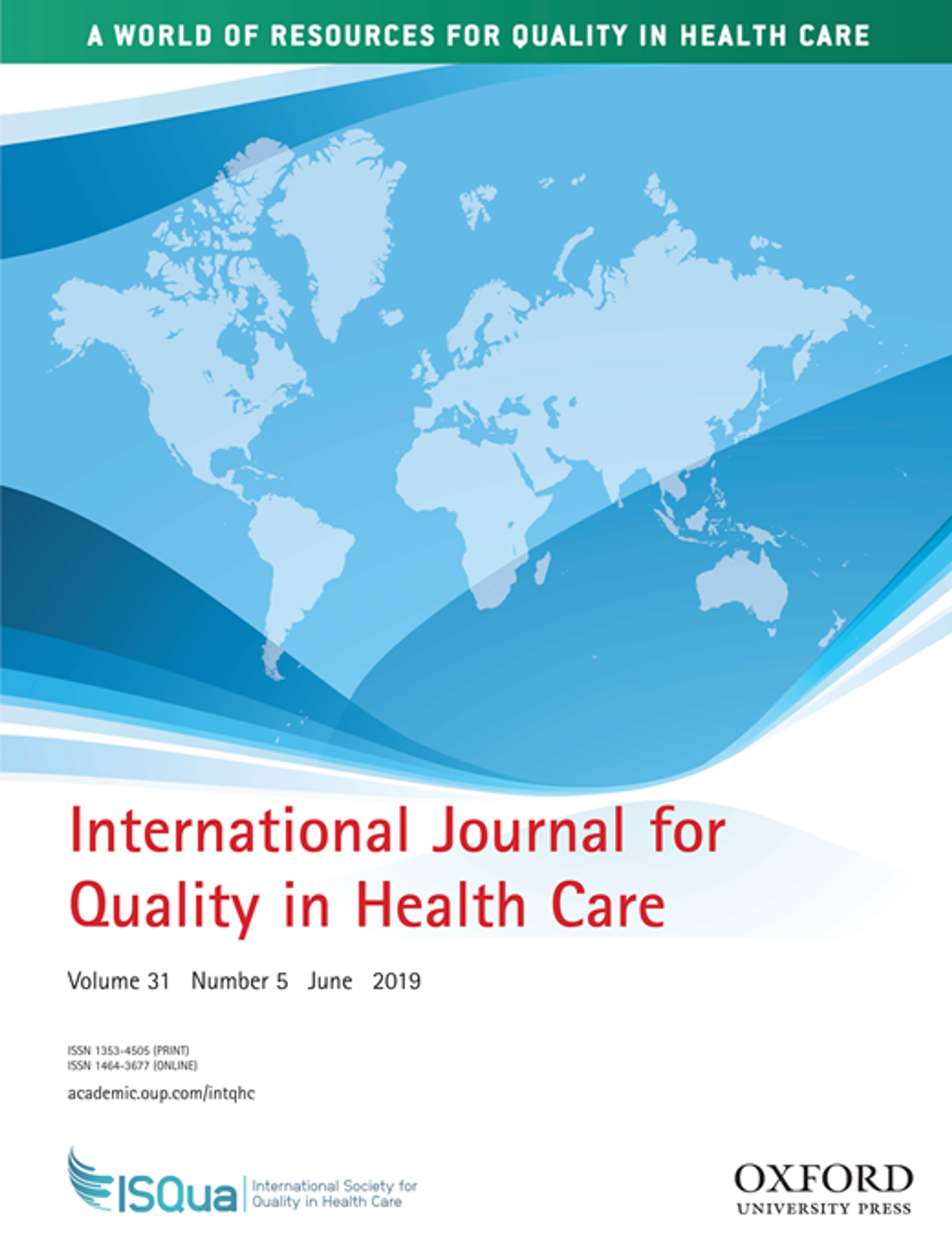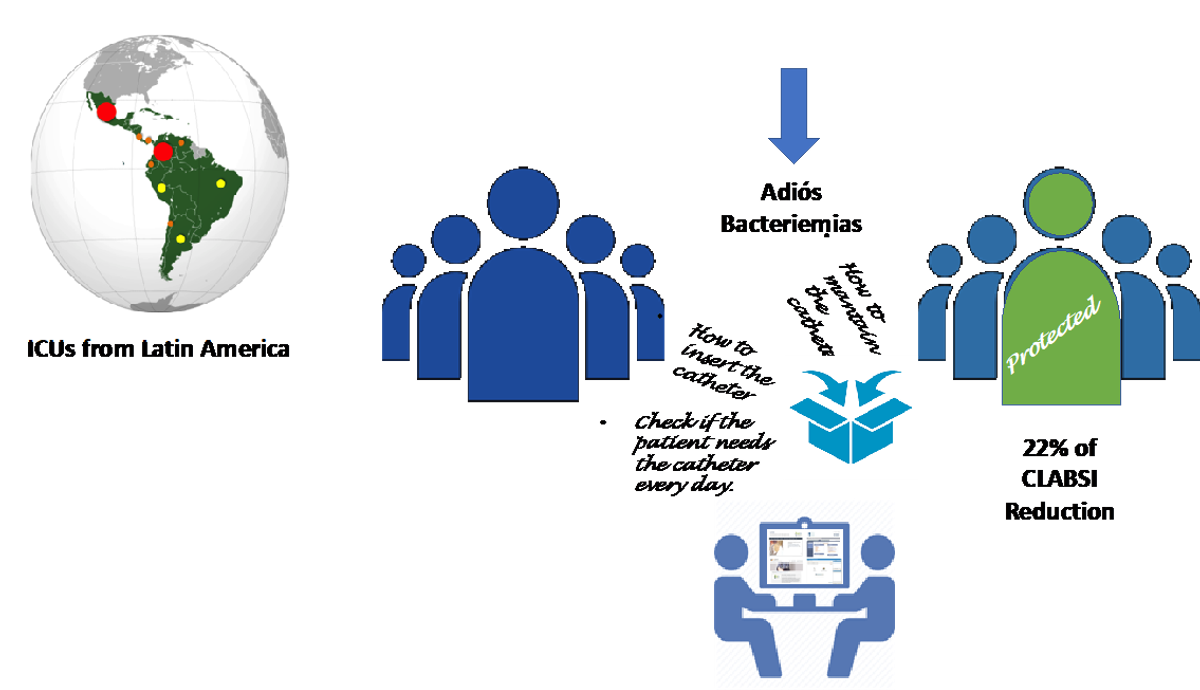Layman Summary

‘Adiós Bacteriemias’: A Multi-Country Quality Improvement Collaborative Project to Reduce the Incidence of CLABSI in Latin American ICUs
Volume 31 Issue 9 - Layman Summary
Catheters are devices that patients need to receive medication, nutrition or blood. Whenever a patient has a catheter (CL) in place, this device breaks the skin and enters into a vein. Broken skin and contact with the bloodstream is a condition that places the patient at risk of infections. Mortality associated with CLABSI is near to 1 out of 5 patients that suffer the infection. These infections can be prevented with a bundle (a combination) of practices. Central line-associated bloodstream infections (CLABSI) in Latin America has been estimated in 4.9 episodes per 1000 days of catheter use (CL) compared to 0.9 episodes per 1000 days of catheter use in the United States. This difference is related to the implementation of the prevention bundle that was used for “Adiós Bacteriemias” Campaign.
This project gathered 39 intensive care units (ICUs) from Latin America from September 2012 to September 2013 in the first phase. The implementation of prevention bundle reduced 56% overall the number of new cases of CLABSI.
How was it done? The authors contacted ICUs´ leaders, trained them to measure the number of CLABSI, provided a guideline to implement the prevention bundle, an extranet to share the number of new CLABSIs and the adherence to the prevention bundle. Materials to spread this knowledge among UCI healthcare workers were provided too. All the contacts among the authors and ICUs were done on-line via webinars.
After a first phase, authors implemented a second phase of the ‘Adiós Bacteriemias’ Collaborative between June 2014-July 2015 in eighty-three ICUs from five Latin American countries. The overall reduction in the CLABSI incidence rate was 22%, from 2.58 episodes per 1000 CL days at baseline to 2.02 episodes per 1000 CL days during the intervention period.
Authors & Affiliations
Jafet Arrieta, Carola Orrego, Dolores Macchiavello, Nuria Mora, Pedro Delgado, Carolina Giuffré, Ezequiel García Elorrio, and Viviana Rodriguez
Address for correspondence:
Ezequiel García Elorrio,
Dr. Emilio Ravignani 2024 (C1414CPV),
Buenos Aires, Argentina.
Tel: +5411 4777 8767; Fax: +5411 4777 8767; E-mail: egarciaelorrio@iecs.org.ar
Read the full paper:
‘Adiós Bacteriemias’ in Chinese
“AdiósBacteriemias”:是一个多国以降低对于拉丁美洲的ICU中CLABSI的发生率质量改进合作项目。
输液管是患者需要接受药物,营养或血液的器械。每当患者使用输液管时,此装置使用时会使皮肤破裂并进入静脉.皮肤破裂和与血管接触的情况会置患者处于被感染风险中。CLABSI相关感染患者的死亡率有接近五分之一。但这类感染可以结合多种实践来诅止。据统计,血管感染在拉丁美洲clabsi输液管使用每1000天为4.9个事件而美国每1000天为0.9个事件。受感染率的不同是因为使用了AdiósBacteriemias。
该项目第一阶段预防措施实践是从2012年9月至2013年9月在拉丁美洲的39个重症监护病房(ICU)实行操作。这些预防措施的实施使CLABSI新病例减少到了56%。怎么做到的?创办者联系到了ICU的负责人,对其进行了培训,以测量CLABSI的数量,为其提供了实施这些预防措施的指南,共享了新的CLABSI数目的外部网以及对这些预防措施的遵守原则。还提供了在ICU医护人员中传播这种知识的材料。创办者和ICU医护工作者之间的所有联系都是通过网络研讨会在线完成的。
经过第一阶段的研究,创办者在2014年6月至2015年7月期间,又在五个拉丁美洲国家的83个ICU中实施了“AdiósBacteriemias”合作研究的第二阶段。 CLABSI发生率的总体降低为22%,在合作干预期间,感染基数从每1000 CL天2.58次降低到每1000 CL天2.02次。
CLABSI-导管相关血流感染
ICU-加护病房
CL-输液管
‘Adiós Bacteriemias’ in Hebrew
"להתראות חיידקים" – שיתוף פעולה למטרת הפחתת מקרי הדבקות בזיהום באמריקה הלטינית.
קטטר הינו מכשיר הנחוץ למטופלים לצורך קבלת הזנה, תרופות או דם. הקטטר, חודר דרך העור אל הוריד,ובכךחותך את העור. עור חתוך והמגע עם זרם הדם הוא מצב המציב את המטופל בסיכון לזיהומים. שיעור התמותה בין אלה שנדבקים בזיהום CLABSIהינו1 מתוך 5.זיהומים אלה ניתנים למניעה במספר דרכים.
באמריקה הלטינית זוהו 4.9 מקרי זיהום מסוג זה לכל 1000 ימי שימוש בקטטר מרכזי, בהשוואה ל 0.9 מיקרים בארה"ב. פער זה נובע מיישום והטמעת הוראות מניעה בארה"ב ששימש למסע פרסום לפרויקט "להתראות חיידקים" באמריקה הלטינית.
בפרוייקט זה נטלו חלק 39 יחידות טיפול נמרץ באמריקה הלטינית מספטמבר 2012 – ספטמבר 2013. יישום הוראות המניעה הפחית ב 56% את מספר מקרי הזיהום החדשים.
איך זה נעשה?
כצעד ראשון תודרכו מנהלי יחידות הטיפול נמרץ כיצד למדוד את מספר המטופלים הלוקים בזיהום זה, הובהרו להם הוראות מניעת הזיהום תוך התקנת רשת אקסטרה-נט[1]המאפשרת שיתוף באשר למספר נדבקי הזיהום החדשים. כמו כן סופקו האמצעים להכשרת כלל עובדי יחידות הטיפול הנמרץ באשר להוראות מניעת הזיהום.
כל הקשר בין היוזמים וה- ICU נעשו באופן מקוון דרך סמינרים מקוונים באינטרנט.
המשך יישום פרוייקט "להתראות חיידקים" שנערך בין יוני 2014 – יולי 2015, ב 83 יחידות טיפול נמרץ ב-5 מארצות אמריקה הלטינית, הביא להפחתת מיקרי הזיהום החדשים ב 22% נוספים: מ 2.58 מיקרים
[1]רשתתקשורתפנימיתשמסוגלתלהתקשרעםגורמיםחיצונייםבעזרתהאינטרנט

